Preventive Maintenance for Scissor Lifts
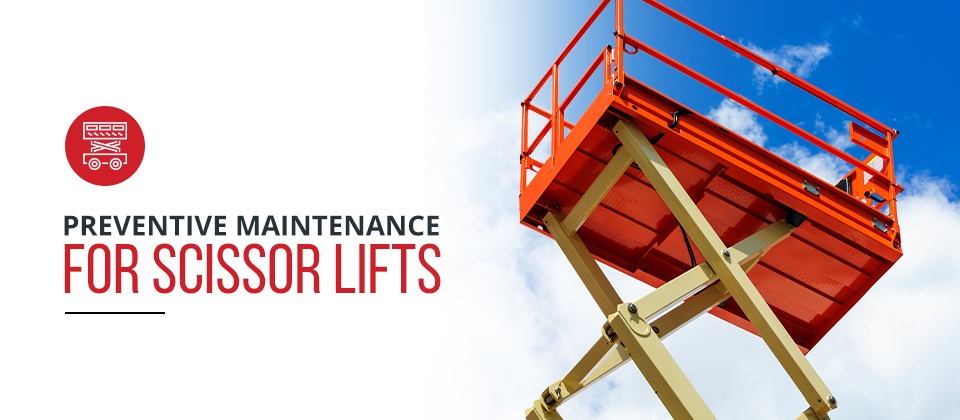
Scissor lifts are crucial to your job site operation. They allow your workers to reach areas that are otherwise out of reach in a safe and controlled manner — which is why scissor lift preventive maintenance is just as critical.
Scissor lift daily inspections and regular maintenance ensure your machines are ready for maximum uptime and performance, whether you’re lifting heavy loads of drywall or working on overhead powerlines. It’s more cost-effective to deal with small repairs as they appear compared to full equipment replacements or rebuilds after putting off smaller issues. Scissor lift maintenance is worth your time and effort long-term for optimal safety and lower costs.
Chicago Industrial Equipment focuses on reconditioning and selling used aerial lift machines so construction and warehouse site managers like you can sustain profitable, productive, and safe operations. We’re here to help you create a preventive maintenance schedule for your scissor lifts.
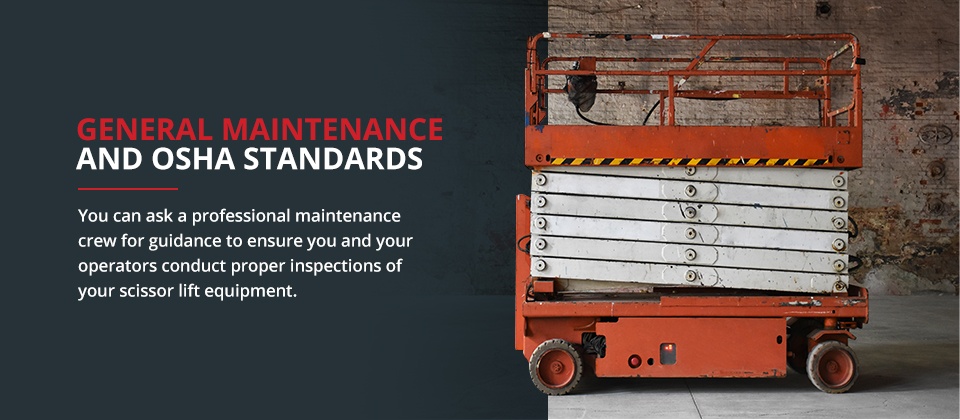
General Maintenance and OSHA Standards
Because there are several different scissor lift models, it’s best to refer to the scissor lift’s particular maintenance manual to understand its requirements. Step one is checking the original equipment manufacturer’s (OEM) operating and maintenance manual. You can also ask a professional maintenance crew for guidance to ensure you and your operators conduct proper inspections of your scissor lift equipment.
Though each scissor lift has unique requirements, there are also general guidelines that cover all scissor lifts. According to the Occupational Safety and Health Administration (OSHA), common hazards associated with aerial lifts include:
- Electric shocks
- Entanglements
- Falls
- Hitting objects
- Tip-overs
Not all accidents and hazards are predictable, but you can lessen the odds through operator training courses. Educating your workers on how to use a scissor lift and how to inspect a unit for damage is a priority for construction and warehouse businesses across the board. Scissor lift operator training should include the following topics:
- An explanation of hazards, including how to look for and avoid them
- What to do in emergency situations
- Recognizing and avoiding unsafe heavy equipment practices
- Proper operation of the lift, including knowing the maximum load capacity
- How to inspect a machine and work site before operating
- Inspection and maintenance guidelines
Scissor lift training, like all heavy equipment training, should be reoccurring. Update your workers as new techniques arise and test their knowledge annually or more often. Comprehensive retraining may also be necessary if an accident occurs, if hazards go unnoticed or if a new machine arrives.
Personal protective equipment is also a nonnegotiable factor when using a scissor lift on the job site. Prepare your workers with a hard hat, fall harness, gloves and other materials that will keep them safe. Only trained and authorized workers should operate a scissor lift.
Creating a Maintenance Plan
Having an aerial lift streamlined maintenance procedure in place for your crew can benefit your company’s bottom line in more ways than one. You can expect a thorough plan to do the following:
- Boost productivity
- Decrease downtime
- Extend service life of scissor lift
- Increase operator safety
- Reduce repair costs
When your machines are running at optimal levels in a safe work zone with trained operators, operations can remain safe and productive. Before creating scissor lift maintenance instructions, consider the following:
- The make and model of aerial equipment
- Required manufacturer upkeep
- When to perform inspections and full maintenance
Inspections and maintenance plans differ. Inspections occur daily and prior to operating. They often involve a walk-around with a detailed look at the machine and its controls to ensure nothing major has happened since its last use. Alternatively, preventive maintenance for a scissor lift is more thorough and takes a deeper look into the unit’s operations.
According to OSHA, heavy equipment should undergo a regular maintenance schedule every 12 months and should not exceed 13 months without service. Depending on how much you use a scissor lift, it’s also recommended that maintenance checks occur every 90 days or 150 hours, depending on which comes first. The best practice to follow involves quarterly and annual maintenance checks performed by qualified maintenance personnel who follow the equipment’s service manual.
In addition to training your operators on safety, you need to ensure daily inspections and quarterly maintenance checks are performed. Caring for your scissor lifts and other pieces of heavy machinery can prevent putting your workers in danger and eliminate massive delays.
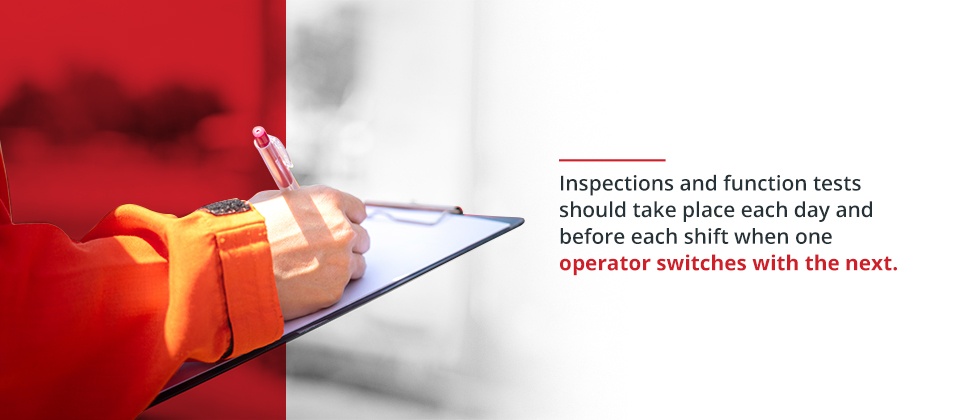
Daily Inspections Before Operating
Inspections and function tests should take place each day and before each shift when one operator switches with the next. While equipment operators should complete daily inspections, maintenance technicians should be responsible for conducting thorough, regular and in-depth maintenance checks.
Ensuring your fleet of heavy equipment is in optimal working condition each day keeps you and your workers safe, and it warrants high productivity levels. No one wants the delay of taking half a day to fix a scissor lift or waiting for it to come out of the repair shop. Walk-around inspections of scissor lifts help keep uptime to a maximum.
A visual examination comes first to see if anything is wrong with the unit. This helps determine if further and more detailed inspections or repairs are necessary. Daily inspections should check the following:
- Brakes
- Charged battery
- Clean control panel
- Controls protected from unintentional operation
- Cracks, leaks and damage
- Drive controls
- Emergency lowering function
- Fluid levels
- Functional upper drive control interlocks
- Guards, rails and basket chain
- Lower operating controls
- Mechanical and switch guards
- Motion alarms
- Operating and emergency controls
- Platform gate
- Readable safety decals, warnings and placards
- Safety indicator lights
- Tire pressure and wheels
- Work platform extension slides
Make sure the operator safety and maintenance manual is handy so workers can reference it when necessary. Train your crew to report any issues they find. When an issue is reported, the maintenance team can make repairs right away, or if it’s a bigger issue, the machine can be taken from the site.
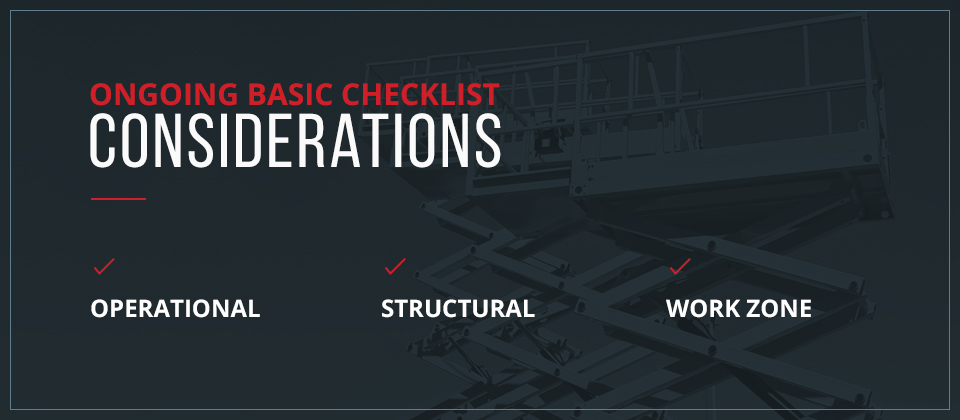
Ongoing Basic Checklist Considerations
Scissor lift construction maintenance that goes beyond visual inspection involves operational, structural and work zone considerations.
1. Operational
Refer to the scissor lift operator’s manual to perform functional tests that aid in discovering technical malfunctions, including:
- Battery charge level
- Brakes
- Controls
- Emergency controls, including gauges, lights, horn and alarms
- Fluid levels, including oil, fuel, hydraulic and coolant
- Leaks
- Steering
- Tires and wheels, including worn treads, cracks in sidewalls and tire pressure
Use this operational checklist to test your scissor lift’s critical functions. If workers discover any faults within the system, they should make an immediate report and the unit should be put out of service until it’s repaired.
2. Structural
Scissor lifts have a platform that raises above its base, whether it’s hydraulic, electric, diesel, pneumatic or a rough terrain machine. The structural checklist includes:
- All systems, including air, hydraulic, pneumatic and electrical
- Cable and wiring
- Emergency and operating controls
- Guardrail stability and rust
- Insulating components
- Lock pins and fasteners
- Loose parts
- Outriggers and stabilizers
- Platform
Again, don’t use the equipment if any components are missing, loose or not functioning.
3. Work Zone
Scissor lift preventive maintenance mainly revolves around the equipment itself. But inspecting your work zone for potential hazards gives operators the opportunity to determine if the site is safe for operation. Examine the work zone for hazards, such as:
- Blind spots
- Debris
- Drop-offs, slopes, bumps, and holes
- High structures and fixtures and overhead obstructions
- High-voltage areas
- Power lines and cables
- Severe weather conditions
- Unauthorized personnel
- Unstable or slippery surfaces
Encourage your operators to check with site supervisors if they have questions about particular obstacles. At the end of their shift, operators should properly shut down and lockout the scissor lift after parking it on a level surface away from obstructions. Lower the platform, turn off the machine and charge the unit’s battery for the next day’s work.
Include this ongoing basic checklist in your training sessions and have a written copy available at all times.
Creating Detailed Records
Keeping a written record of your heavy equipment maintenance checks is another part of a maintenance plan. Here, you should include things like what was wrong and why, as well as the time and date. It’s imperative to have a detailed record in case an accident occurs. With specifics on repairs and replacements, you can look at these records and prove proper maintenance to potentially avoid fines or legal action.
While you can go the traditional route by keeping scissor lift records with a pen and paper, you can also use advanced methods like maintenance software. Technology like this can help you create an easy and viable maintenance schedule to follow. The system can also alert you when maintenance dates are close. Depending on the technology, it can even help you compare repair costs between your scissor lift machines. This aids you in determining whether maintenance or a full replacement is necessary.
Common Issues: Battery Maintenance
One of the most crucial steps within your preventive maintenance program involves the battery. An improperly maintained scissor lift battery can degrade over time, which often leads to premature replacement — costing you downtime and money. In many cases, the battery can be the highest-cost replacement for scissor lifts. It’s wise to keep up with routine inspections and regular maintenance to ensure adequate water levels and a charged battery. Consider the following battery best practices:
- Keep it clean and dry: Clean the battery banks of built-up dirt and debris. Otherwise discharge can surface, which affects the operating time in between each charge
- Conduct a performance test: Test the battery using a digital battery tester, also called an amp-draw test
- Perform a charge test: Make sure the battery is charging properly and replace bad ones as necessary
There are other common practices to be aware of to certify that your scissor lift battery is working and will maintain a long life. First, review the manufacturer’s specifications. Some battery requirements may include not using an external charger. Next, plug the battery into an alternating current (AC) outlet in a well-ventilated area. The battery compartments may need to be open during the charging process.
Make sure to use the proper input voltage and to only use an authorized charger and battery that fit the make and model of the scissor lift. Step three is to connect the battery before charging. If you’re charging a wet battery with caps, remove the unit and inspect its acid level while wearing personal protective equipment.
Follow the appropriate procedures to fill the battery if necessary. You can do this by adding distilled water to cover the plates, making sure not to overfill. Replace the vent caps and connect the battery unit to its charger. Finally, check the acid level once the charger indicates the battery is fully charged. Read the operator’s manual for specific information associated with your machine and battery.
Another tip is to charge the battery for long periods at a time as opposed to several short sessions throughout the day. Charging a battery for short periods can affect the unit’s longevity. Most machines have battery level indicators, so if it’s low, take the scissor lift out of service because certain operations may be disabled on some models.
Proper battery maintenance is essential to a scissor lift’s performance as well as keeping up with safety measures.
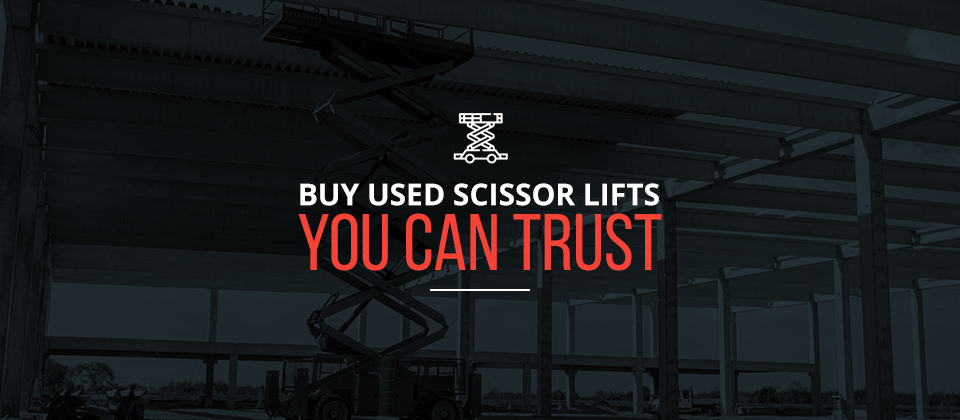
Buy Used Scissor Lifts You Can Trust
Chicago Industrial offers reconditioning used aerial lifts, including scissor lifts, for construction managers and warehouse businesses who need reliable and safe machines on hand. Our scissor lifts safely lift workers and materials to heights up to 150 feet. Each piece of equipment goes through a rigorous inspection, and we check each unit before it leaves the shop.
Used scissor lifts are cost-effective and reliable investments. We know that buying new isn’t always a reasonable solution for your business. Chicago Industrial Equipment sells quality machines at competitive prices to support your operations while keeping your crew safe.
Contact us online to learn more about our used scissor lifts or call us at 1-815-744-8811 to speak with a representative.

